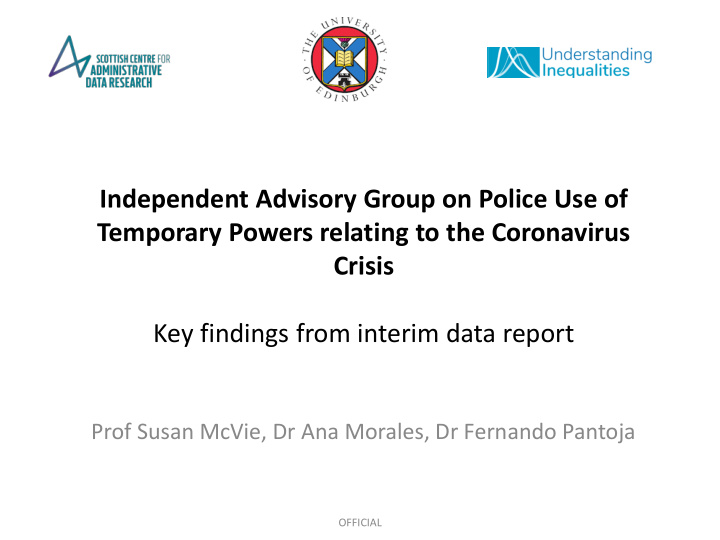



Independent Advisory Group on Police Use of Temporary Powers relating to the Coronavirus Crisis Key findings from interim data report Prof Susan McVie, Dr Ana Morales, Dr Fernando Pantoja OFFICIAL
Structure • Data gathering process • Key findings: – Police use of the powers – Change over time – Wider policing context – Public response OFFICIAL
Data gathering process • 3 priority areas relating to Operation Talla: – Police application of the powers – Public acceptability of the powers – Public compliance with the regulations Crime/ Coronavirus Ticketing incident Intervention system System Systems Police Citizen Public officer space surveys interview portal OFFICIAL
Police use of the powers • 53,112 interventions from 27 th March to 17 th June Forcible Fixed Penalty removal/Arrest Notice 1% 6% Dispersal after instruction 19% Dispersal after information 74% OFFICIAL
West = 66% East = 22% North = 12% OFFICIAL
OFFICIAL
Rate of interventions per 100,000 population (age 16-59) L - Argyll & West Dunbartonshire G - Greater Glasgow C - Forth Valley K - Renfrewshire & Inverclyde U – Ayrshire N - Highland & Islands V - Dumfries & Galloway E – Edinburgh D – Tayside P – Fife Q – Lanarkshire J - The Lothians & Scottish Borders Average A - North East 0 1000 2000 3000 4000 5000 6000 7000 8000 9000 OFFICIAL
OFFICIAL
Type of intervention as a % of all activity, by Division E – Edinburgh N - Highland & Islands L - Argyll & West Dunbartonshire K - Renfrewshire & Inverclyde C - Forth Valley D – Tayside V - Dumfries & Galloway P – Fife J - The Lothians & Scottish Borders G - Greater Glasgow U – Ayrshire A - North East Q – Lanarkshire 0% 10% 20% 30% 40% 50% 60% 70% 80% 90% 100% Dispersal after information Dispersal after instruction Fixed Penalty Notice Forcible removal/arrest OFFICIAL
Change over time PM announces FM relaxes Phase 1 starts plans to publish restriction route map on exercise OFFICIAL
Gradual rise in activity in early lockdown, peaking in early May then falling OFFICIAL
Peak in activity during early lockdown followed by a decline OFFICIAL
A clear rise in activity towards the end of June OFFICIAL
No clear pattern in activity during lockdown OFFICIAL
OFFICIAL
Wider policing context Country Total number of Population size Rate per 10,000 Difference to FPNs issued population Scotland to 8 th June 2020 +22% 7.3 Wales 2,282 3,138,631 6.0 - Scotland 3,240 5,438,100 2.8 -53% England 15,715 55,977,178 Caution is required in interpreting cross-country comparisons ! OFFICIAL
Change in the number of incidents recorded and proportion receiving resource allocation OFFICIAL
Change in incidents by type OFFICIAL
Public response to police use of powers • 40 responses to the Citizen Space Portal • Not a demographically representative group • Only 13 reported they or a friend/family member having police contact during lockdown • Overall, experience of police contact was positive • But equally divided between ‘satisfied’ and ‘disappointed’ OFFICIAL
• Most people had not changed their opinion of the police during lockdown • Positive comments included: – appreciation for the frontline role of police officers (‘ Police Officers have put themselves at risk to protect the health of our nation’) – High opinion of local community policing – Little use of enforcement • Negative comments included: – Excessive and unnecessary use of the powers – Too little and infrequent use of the powers – Little use of enforcement is not a deterrent OFFICIAL
• There was recognition of the challenges faced by the police in exercising the powers • There was praise for Police Scotland’s communications around the 4 E’s • There was annoyance that more direct action/enforcement had not been taken towards those seen breaching the rules • There was frustration amongst some who felt the restrictions no longer served any purpose OFFICIAL
• There was no significant change in the total number of official complaints received by Police Scotland during lockdown. • Only Lanarkshire had a significantly higher number of complaints in the two months following lockdown. • The rate of complaints following lockdown varied across Divisions OFFICIAL
• On average, there were 25 Operation Talla complaints per Division in the two months following lockdown • The proportion of all complaints relating to Operation Talla varied across Divisions OFFICIAL
64% of complaints during lockdown were dealt with through frontline resolution (an increase from 42%) There was an increase in use of frontline resolution across all Divisions, but this was largest in the West OFFICIAL
Conclusions • The lockdown had a significant impact on operational policing in Scotland, both in terms of Operation Talla and traditional policing demand and response • There are substantial differences across Divisions in the extent and timing of use of the powers, but considerable consistency in the application of the 4 E’s strategy • There was very little use of enforcement, and this was primarily used at the start of lockdown • Policing capacity has been redeployed where necessary to cope with the emerging challenges during lockdown • Public opinion of policing is largely positive and unchanged, but there is a tension between those who want more use of the powers and those who want less • There has been no increase in complaints against the police as a result of the pandemic, but there has been an increase in use of frontline resolution OFFICIAL
Recommend
More recommend